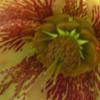
I wonder how many of gardeners could with all honesty look at the garden they have created objectively and take drastic actions to completely reinvent the atmosphere and flow of the space. This is exactly what Sir Roy Strong has done at The Laskett, the garden he created with his late wife, Julia Trevelyan Oman, over a period of 30 years. After her death in 2005 Sir Roy took the pragmatic approach that the house and garden had to work for him as a single individual and he started the process of really analysing the space. The book, Remaking a Garden, charts the changes made over a period until 2013.
Sir Roy provides the back ground to the garden and then a short narrative for each of the section explaining the history of that part of the garden and what changes were made and why. I enjoy Sir Roy’s writing having also read his book on the creation of the garden. He adopts an approach of talking to you as if you are a friend of his and although the text is littered with references to friends and colleagues, his wife’s theatrical productions and his own work it doesn’t, to me, come across as inaccessible. The narrative is accompanied by a photographic journal supplied by Clive Boursnell who charted the garden over 2013 as well as taking photographs of earlier alterations; it is predominantly a visual book. As I write a monthly meme on this blog charting the changes in my garden through the year this kind of approach really appeals to me.
The primary changes made to the garden were the removal of hedges that were planted in the early days of the couple creating the garden and had grown very tall and become, to Sir Roy, quite suffocating. Sir Roy gives us the odd insight into his marriage and the character of his late wife. He tells us how Julia craved privacy, which I presume is a reaction to a very public life when they were both at work in London. To achieve this she welcomed the high hedges and large trees blocking views of the house and garden from the road and neighbouring fields and in the house she adorned the windows with heavy curtains and plants. In Sir Roy’s new world these are taken away and the light is allowed to flood into the garden and house, in fact reference to light proliferates throughout the text which shows how important it has become to Sir Roy.
It is interesting to see, through the photographs, how cutting into the hedges to create swags and scoops around entrances to areas draws the eye across the garden and creates vistas where previously the view was blocked. A lot of thought has been given to the visitor’s experience of the garden with various plantings being changed and replaced with plants with a longer season of interest. A new colonnade was built last year in order to provide a dry space for visitors when it rained. I have to admit that this new area jarred with me when I visited in 2013 and it seemed a strange addition but now having read the book I understand the motivation for the construction and appreciate that the space will need some time to mellow and settle into its surroundings.
I think, as I said when I posted about my visit in 2013, that this garden is better appreciated when you understand some of its history and the motivation behind the various sculptures and topiary and I think this is something Sir Roy appreciates too. I don’t think I have encountered a garden before where understanding the history behind things makes such a difference to your appreciation which I think is very interesting. I visited in 2013 with a group of people who weren’t really into gardens and they were completely preoccupied with the self-referential objects that adjourned the garden finding this approach very strange. However, I found them fascinating and to me The Laskett is a form of autobiography but in a horticultural format and why shouldn’t you have sculptures and objects that remind you of key and important events in your life.
This is a large and glossy book giving the appearance of a coffee table book. However, whilst it is fascinating to flick through the photographs, once you start to read the text you really gain an understanding of the thought processes behind the changes made. I found it quite liberating – why not chop down a huge tree if it is blocking out light? I think sometimes we spend too much time worrying about whether we are doing the right thing that inertia sets in and nothing happens so I found Sir Roy and his gardeners quite ruthless and unsentimental approach refreshing. It was also interesting to read how one change lead to another change and sometimes it took a serious of changes before Sir Roy felt that he had finally achieved the right effect.
However, Sir Roy’s love of his wife and his gardeners’ respect for her also come through. There is one area, the Christmas Orchard, which holds part of her collection of heritage apple trees under which her ashes were scattered which has only been tidied and will not be changed. Also the gardeners had to reduce the crab apple tree collection and find homes for some of the younger trees so they replanted some of them by bus stops around Herefordshire, which really made me chuckle.
I suspect that knowing and enjoying The Laskett has added to my enjoyment of this book making me somewhat prejudice but I honestly think it would appeal to any one who is interested in the thought process of garden creation and when is it not fascinating to have a peer behind the scenes of a garden.

